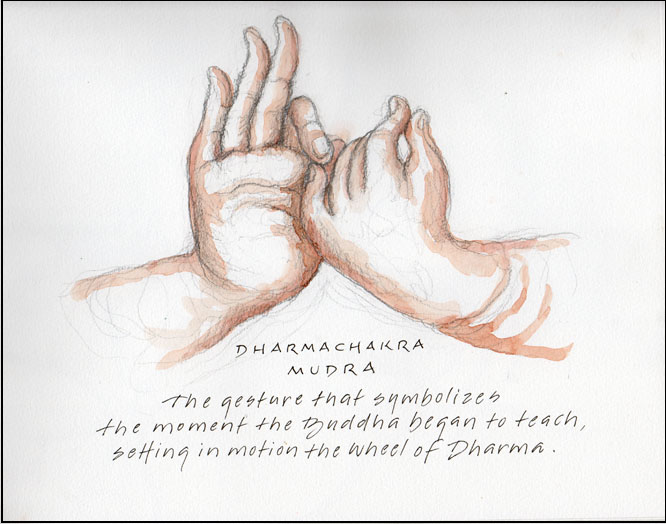Early in the morning we take off for Ajanta
with our steady driver Takrit.
Steve and Takrit talk throughout the two hour trip
and I gaze out the window, sketching details of life along the road,
feeling surprisingly relaxed for being in a car in India
(usually a terrifying experience ! )
Takrit drops us off at the parking lot and we line up to ride the buses
that take everyone to the entrance of this World Heritage site -
twenty-six caves lining the edge of a remote gorge -
carved and painted between 200 and 500 AD -
most of the art created during an intense twenty year period and then abandoned
as the looming chaos of war enveloped it all.
A flowering of painting and sculpture from long ago.
We begin to explore . . .
The cave walls are painted exquisitely with court scenes
and stories of the Buddha's lives,
but the spaces are so dark, the images so severely damaged,
just fragments remain.
My eyes are straining as I try to make out the details with binoculars and a flashlight.
Finally I settle into a corner of a deep inner chamber
that has one electric light on the large Buddha statue.
His hands are intact, not broken or damaged,
and powerfully expressive.
As I sketch Indian families gather one after another to be photographed
in front of the huge sculpture . . .
We move along through the caves,
trying to get a sense of the spaces, and the lives lived within them.
Did Buddhist monks practice here ?
Who were the artists ? Who were the patrons ?
How did it come so quickly to an end ?
At the last cave I find a small spot to sit and gaze
on the long stretched out body of the Buddha . . .
I'm in a narrow space, with people filing by
and a guard nearby yelling "No flash ! No flash!"
Even so I'm feeling settled and happy being with this quiet resting form.
A man stops to tell me about his connection with vipassana meditation
and the centers worldwide. I turn to him and say,
"Sounds like what the world needs ! "
I move a few feet down and begin another drawing -
Now the guard is telling me I have to move on - finish up quickly.
As he stands there waiting impatiently he remarks,
"Don't you have a camera ?!"
On the drive back at the end of the day . . .









What a treasure, Barbara. Thank you for taking us along on your quest. I could feel your awe and your slowing down, despite the push of others and the guard. I hope you asked the one who suggested you use a camera if he had any idea of how long it took the artists so long ago to create the images that still capture imaginations today. May you continue to follow your heart.
ReplyDeleteStanding on top of Mount Washington, I crudely sketched the dramatic forms of an approaching cold front. A man draped with lots of analog camera equipment suggested kindly that using a camera would be quicker. I was too polite to tell him that I had a camera, but that drawing has the power to slow down time, and my life goes by fast enough already.
ReplyDeleteI am in the inner chamber with you.
ReplyDeleteThe Buddha's hands are alive,
All that you sketch is alive and yet
so long ago.
I hear the guards
I see the people,
I wander with the bristly pigs!
Thank-you
Thank-you!
Barbara - I have just found your blog and what a treasure it is! I love your book, True Nature, reading it over and over with each change of season. This morning, I read Spring again and it touched me deeply. Thank you for your generosity in continuing to share your thoughts and your drawings! I'll be back to visit you here often.
ReplyDeleteHi Barbara,
ReplyDeleteTwo weeks ago I emerged from the caves of Matera, Italy, where Elaine Colandrea was teaching continuum and we also spent a lot of time looking at Christian cave paintings. I am just now reaclimating and it was fun to join you in your caves. Thanks for the lovely tour.
Glad to have another cave voice ! It's a particular inner space to view one's life deeply . . .
ReplyDelete